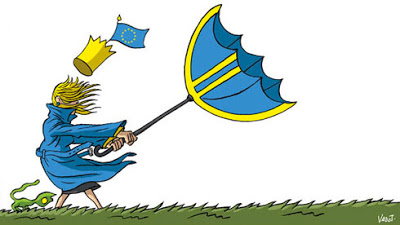 ECB President Draghi said nothing to dampen expectations that in December, with the cover of new staff forecasts, the asset purchase program will likely be extended. This is a function of two assessments. First, risks are biased to the downside. Second, there are not convincing signs of an upward trend in underlying inflation.
ECB President Draghi said nothing to dampen expectations that in December, with the cover of new staff forecasts, the asset purchase program will likely be extended. This is a function of two assessments. First, risks are biased to the downside. Second, there are not convincing signs of an upward trend in underlying inflation.
The euro initially slipped toward session lows, but when Draghi shared that an extension of QE was not discussed (nor was tapering, the euro rallied. This is not a significant. It means nothing about what the ECB may do in December. There are two months before that meeting, and this is very much part of the ECB’s modus operandi. Make a decision only when necessary. The squeeze higher quick ran out of steam and the euro returned toward its lows.
The December meeting brings an update on the Eurosystem committees reviewing the ECB’s tools, and there will be new staff forecasts. Sequentially, these are important to have an informed discussion that will lead to new actions. Draghi did reiterate that an abrupt end to the purchases was unlikely, which means tapering is still the most likely scenario. Draghi left no doubt that December is crunch time: “It’s quite clear our decisions in December will tell you what we are doing in the coming months.”
As widely anticipated there is very little new from the ECB today. Market participants are unlikely to change views of the trajectory of ECB policy. An extension of QE is likely, and most think by six months. A break of $1.0950 may spur a test on the Brexit low near $1.0915. A move below would target $1.08. In contrast to Draghi, recent comments by the Fed’s Fischer and Dudley keep expectations of a Us hike in December very much alive, barring a downside shock in the coming period. Last year finished with a focus on divergence. This year is headed in the same direction.
 ECB President Draghi said nothing to dampen expectations that in December, with the cover of new staff forecasts, the asset purchase program will likely be extended. This is a function of two assessments. First, risks are biased to the downside. Second, there are not convincing signs of an upward trend in underlying inflation.
ECB President Draghi said nothing to dampen expectations that in December, with the cover of new staff forecasts, the asset purchase program will likely be extended. This is a function of two assessments. First, risks are biased to the downside. Second, there are not convincing signs of an upward trend in underlying inflation.







































